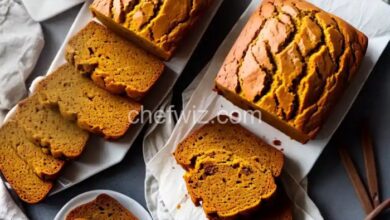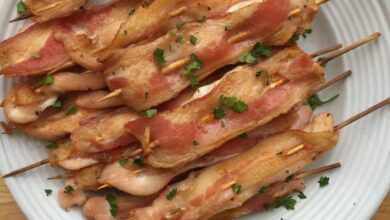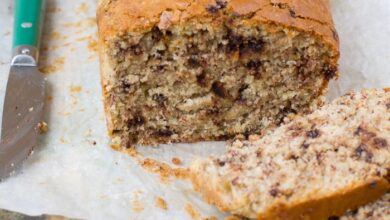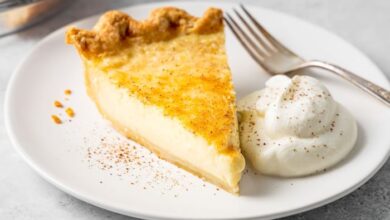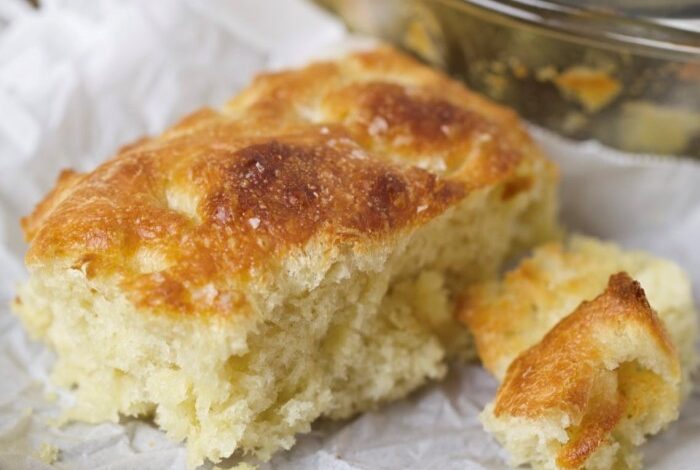
No Knead Big Bubble Focaccia: Easy, Delicious, and Effortless
No knead big bubble focaccia is a culinary dream come true, offering a delicious and satisfying bread experience without the hassle of traditional kneading. Imagine a crusty, golden-brown loaf, studded with airy bubbles that melt in your mouth, revealing a symphony of flavors.
This is the magic of no-knead focaccia, a recipe that embraces simplicity and yields extraordinary results.
The secret lies in the long, slow fermentation process, where the dough develops its signature airy texture and deep, complex flavors. The high hydration of the dough contributes to the large bubbles, creating a bread that is both visually stunning and incredibly light.
Whether you’re a seasoned baker or a beginner, no-knead focaccia is a recipe that will empower you to create something truly special in your own kitchen.
No-Knead Big Bubble Focaccia: A Baking Delight
Imagine a focaccia, not just any focaccia, but one with impossibly large, airy bubbles that rise like clouds, giving it a light and airy texture. This is the magic of no-knead focaccia, a recipe that promises a delicious and impressive bread with minimal effort.
Forget about the tedious kneading process, this method simplifies baking, allowing you to spend less time in the kitchen and more time enjoying the fruits of your labor.
The Simplicity of No-Knead Focaccia
The beauty of no-knead focaccia lies in its simplicity. The dough requires minimal attention, allowing you to focus on other tasks while it rises. The secret lies in the long, slow fermentation process, which develops a complex flavor and creates those signature big bubbles.
Key Ingredients and Their Roles
The key to achieving the perfect no-knead focaccia lies in the ingredients:
Flour
High-protein flour
This type of flour, also known as bread flour, is essential for achieving a strong gluten structure, which is responsible for the focaccia’s airy texture.
All-purpose flour
This flour can also be used, but it may require a bit more yeast to compensate for its lower protein content.
Yeast
Active dry yeast
This type of yeast is readily available and requires activation in warm water before being added to the dough.
Instant yeast
This yeast is more convenient as it doesn’t need to be activated.
Water
Warm water
The yeast thrives in warm water, which helps it activate and begin the fermentation process.
Salt
Salt
This enhances the flavor of the focaccia and helps to control the yeast’s activity.
Oil
Olive oil
This oil adds richness and flavor to the focaccia and helps to create a crispy crust.
Benefits of No-Knead Method
Time Savings
No-knead focaccia is all about those big, beautiful bubbles that rise to the surface, creating a soft, airy texture. It’s the kind of bread that makes you want to tear off a chunk and savor every bite. And while I’m on the topic of deliciousness, have you ever tried making bbq country style ribs ?
They’re a perfect match for a hearty loaf of focaccia, especially if you’re hosting a barbecue. The smoky, tangy ribs pair beautifully with the focaccia’s buttery, savory flavor. It’s a combination that’s sure to please everyone at the table.
The no-knead method significantly reduces the time spent on preparing the dough. You simply combine the ingredients, let the dough rise for a long time, and then shape it.
Ease of Preparation
This method requires minimal effort and is perfect for busy bakers.
Improved Flavor
The long fermentation process allows the flavors to develop fully, resulting in a more complex and delicious focaccia.
The Dough
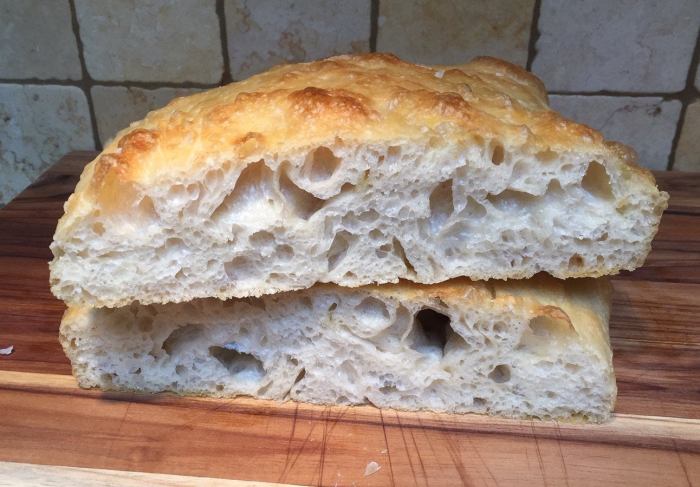
The magic of no-knead focaccia lies in its simple, yet ingenious dough. It’s a testament to the power of patience and the beauty of slow fermentation. This method allows the dough to develop a unique character, resulting in a focaccia that’s both flavorful and texturally delightful.The process of creating this dough is a dance between time and ingredients, with each step playing a crucial role in shaping the final product.
Let’s delve deeper into the key elements of this no-knead journey.
Autolyse
Autolyse, meaning “self-dissolving,” is the initial step where the flour and water are mixed and allowed to rest for a period of time. This step allows the gluten in the flour to relax and absorb the water, creating a smooth and elastic dough.
During autolyse, the flour’s starches also begin to break down, contributing to the development of flavor. This process also aids in the hydration of the flour, leading to a more cohesive and workable dough.
Long Fermentation
The long fermentation process is where the real magic happens. It’s the heart of the no-knead focaccia method, allowing the dough to develop its signature texture and flavor. The extended fermentation time allows the yeast to slowly break down the sugars in the flour, producing carbon dioxide and alcohol.
This process contributes to the airy and bubbly texture of the focaccia, while also enhancing its flavor profile.
I love the rustic charm of a no-knead big bubble focaccia. It’s so simple to make, and the results are always impressive. The airy texture and crispy crust make it the perfect companion for a hearty meal like a awesome broccoli cheese casserole.
Speaking of which, I think I’ll whip up a batch of that casserole tonight to go with my focaccia. It’s a classic comfort food combination that never fails to please!
The longer the fermentation, the more complex the flavors develop.
High Hydration Dough
The high hydration of the dough is another defining characteristic of no-knead focaccia. This means that the dough contains a higher proportion of water compared to flour, resulting in a wetter and more elastic dough.This high hydration contributes to the focaccia’s airy texture, as the gluten network expands during fermentation, trapping air bubbles.
It also allows the dough to stretch and spread easily, creating those characteristic large bubbles.
There’s something so satisfying about the big, bubbly texture of no-knead focaccia. It’s the perfect canvas for a variety of toppings, but sometimes I crave something a little more decadent. That’s when I turn to the crispy, gooey goodness of gluten free fried cheese curds.
The combination of the fluffy focaccia and the cheesy, crispy curds is simply irresistible! Back to the focaccia, though, I love how easy it is to make. Just mix, let it rise, and bake. It’s perfect for a casual weeknight dinner or a weekend gathering with friends.
A high hydration dough typically ranges from 70% to 80%, meaning that for every 100 grams of flour, there are 70 to 80 grams of water.
Shaping and Proofing
The shaping of no-knead focaccia is a simple yet crucial step that sets the stage for its signature rustic appearance and airy texture. Unlike other bread recipes, focaccia doesn’t require intricate folding or shaping, allowing you to embrace a more relaxed approach.
Shaping Technique
The goal is to create a dough that is evenly distributed in the baking pan while maintaining its uneven, rustic surface. This is achieved through a gentle pressing and stretching technique, allowing the dough to naturally form peaks and dips.
The key is to handle the dough delicately, avoiding excessive manipulation that can deflate the air pockets.
The process involves:
- Gently transferring the dough from the bowl to a lightly oiled baking sheet or pan.
- Using your fingertips, gently press the dough into the pan, ensuring it reaches the edges.
- Stretch the dough outwards, creating a thin layer while maintaining some thickness in the center.
- Use your fingertips to create dimples and indentations on the surface, allowing for the characteristic focaccia bubbles to form during baking.
Proofing for Airy Bubbles
Proofing is the final stage before baking, where the dough rises and develops its airy texture. During this time, the yeast continues to work, producing carbon dioxide gas that gets trapped within the dough, creating the characteristic large, airy bubbles.
Proper proofing is essential for achieving a light and airy focaccia with a pleasingly chewy texture.
Optimizing the Proofing Process
- Warm Environment:Yeast thrives in a warm environment, typically between 70-80°F (21-27°C). A warm oven with the light on or a proofing box can provide the ideal temperature.
- Humidity:Maintaining a humid environment helps prevent the dough from drying out, allowing for a more even rise. You can achieve this by placing a bowl of hot water near the dough or using a proofing box with a humidity control feature.
- Time:The proofing time can vary depending on factors like temperature and dough hydration. It typically takes 2-4 hours for the dough to double in size. You can check the dough’s readiness by gently pressing it with a finger; it should slowly spring back.
Topping and Baking
The no-knead focaccia dough is incredibly versatile, allowing for a wide array of toppings to customize its flavor and appearance. From classic herb combinations to creative vegetable arrangements, the possibilities are endless. This section explores the art of topping your focaccia, emphasizing the importance of arranging toppings for a visually appealing and flavorful presentation, as well as understanding the crucial role of baking temperature and time in achieving a golden crust and perfectly cooked interior.
Topping Choices
Toppings play a significant role in defining the character of your focaccia. They not only enhance its visual appeal but also add a layer of complexity to its flavor profile.
- Herbs:Fresh herbs are a classic choice for focaccia. Rosemary, thyme, oregano, and basil are popular options, offering a fragrant and aromatic experience.
- Vegetables:Sliced onions, cherry tomatoes, bell peppers, and artichoke hearts add texture and vibrant color to the focaccia.
- Cheese:Grated Parmesan, mozzarella, or a combination of both can be sprinkled over the focaccia for a savory and melty finish.
- Olive Oil:A generous drizzle of extra virgin olive oil enhances the focaccia’s flavor and creates a beautiful sheen.
Arranging Toppings
The arrangement of toppings is crucial for both aesthetic and culinary reasons.
- Visual Appeal:A visually appealing focaccia is a testament to the baker’s artistry. Consider using contrasting colors, textures, and shapes to create an eye-catching presentation.
- Flavor Distribution:Arranging toppings strategically ensures that each bite offers a balanced blend of flavors.
Baking Temperature and Time, No knead big bubble focaccia
The baking process is essential for achieving a golden crust and a perfectly cooked interior.
- Temperature:Baking focaccia at a high temperature, typically around 450°F (232°C), helps to create a crispy crust.
- Time:The baking time depends on the size and thickness of the focaccia. A typical baking time is around 20-25 minutes.
Serving and Storage: No Knead Big Bubble Focaccia
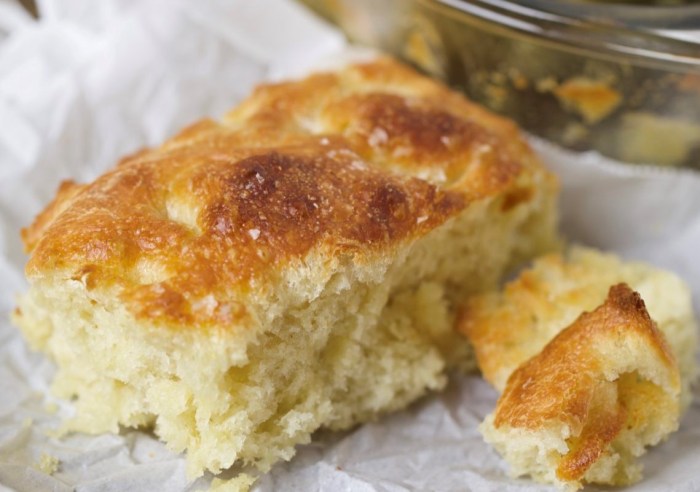
Your no-knead focaccia, with its airy bubbles and irresistible aroma, is ready to be enjoyed! But how to serve it best? And how to keep it fresh for those inevitable leftovers? Let’s explore some ideas.
Serving Suggestions
Focaccia’s versatility shines through in its many serving options. It can be a delicious side dish, a captivating appetizer, or even a hearty sandwich bread.
- Side Dish:Imagine your focaccia, warm and slightly crisp, alongside a hearty bowl of soup or a simple salad. The contrast of textures and flavors creates a delightful culinary experience.
- Appetizer:Cut your focaccia into bite-sized pieces and top them with various ingredients for a delectable appetizer. Think savory options like olives, sun-dried tomatoes, or roasted peppers, or go sweet with a drizzle of honey and a sprinkle of rosemary.
- Sandwich Bread:The airy texture of focaccia makes it a fantastic choice for sandwiches. Its slightly chewy crust adds a satisfying crunch, while its soft interior cradles your fillings perfectly. Experiment with different fillings, from classic Italian meats and cheeses to fresh vegetables and flavorful sauces.
Storing Focaccia
To ensure your focaccia remains fresh and delicious, proper storage is crucial. Here are some effective methods:
- Room Temperature:For optimal flavor and texture, enjoy your focaccia within the first 24 hours. Store it at room temperature, wrapped in a clean kitchen towel or placed in an airtight container.
- Refrigeration:If you need to store your focaccia for a longer period, place it in an airtight container and refrigerate for up to 3 days. However, refrigeration can make the focaccia slightly less crisp. To revive its texture, reheat it in a low oven or toaster oven for a few minutes.
- Freezing:Freezing is a great option for storing focaccia for longer periods. Wrap the focaccia tightly in plastic wrap or aluminum foil and freeze for up to 2 months. To thaw, remove the focaccia from the freezer and let it thaw at room temperature for a few hours.
Reheat it in a low oven or toaster oven before serving.
Storage Methods and Shelf Lives
Here’s a table summarizing the storage methods and their respective shelf lives:
| Storage Method | Shelf Life |
|---|---|
| Room Temperature | Up to 24 hours |
| Refrigeration | Up to 3 days |
| Freezing | Up to 2 months |
Variations and Experimentation
The beauty of focaccia lies in its versatility. It’s a blank canvas for culinary creativity, inviting you to explore a world of flavors and textures. From classic combinations to daring new creations, there’s a focaccia for every palate.
Flavor Combinations and Toppings
The possibilities for flavor combinations and toppings are truly endless. You can stick with traditional ingredients like rosemary and sea salt, or venture into more adventurous territory with fig and prosciutto. Here are some ideas to get you started:
- Herbs and Spices:Experiment with different combinations of fresh or dried herbs like thyme, oregano, basil, and parsley. Add a touch of spice with red pepper flakes, black pepper, or a sprinkle of garlic powder.
- Vegetables:Roasted vegetables like bell peppers, onions, and zucchini add a burst of color and flavor. Caramelized onions and sun-dried tomatoes are also excellent choices.
- Cheese:Shredded mozzarella, parmesan, or goat cheese are all classic choices. Try adding a dollop of ricotta or a sprinkle of crumbled feta for a tangy twist.
- Fruits:Sweet and savory combinations are always a hit. Try topping your focaccia with slices of figs, grapes, or pears. A drizzle of honey or balsamic glaze adds another layer of complexity.
- Meats:Thinly sliced prosciutto, pancetta, or chorizo add a salty and savory note. Consider using a combination of meats and cheeses for a more decadent focaccia.
Rosemary and Sea Salt Focaccia
This classic combination is a perfect example of how simple ingredients can create a truly delicious focaccia. The earthy flavor of rosemary pairs beautifully with the salty crunch of sea salt.
Ingredients:
- 1 tablespoon fresh rosemary needles
- 1 teaspoon sea salt
- Olive oil, for drizzling
Instructions:
- Preheat oven to 450°F (230°C).
- Brush the top of the focaccia dough with olive oil.
- Sprinkle evenly with rosemary needles and sea salt.
- Bake for 20-25 minutes, or until golden brown and cooked through.
Fig and Prosciutto Focaccia
For a more sophisticated focaccia, try this fig and prosciutto combination. The sweetness of the figs contrasts beautifully with the salty prosciutto, creating a flavor explosion in your mouth.
Ingredients:
- 4 fresh figs, thinly sliced
- 4 ounces prosciutto, thinly sliced
- 1/4 cup crumbled goat cheese
- Olive oil, for drizzling
- Balsamic glaze, for drizzling
Instructions:
- Preheat oven to 400°F (200°C).
- Brush the top of the focaccia dough with olive oil.
- Arrange the fig slices, prosciutto slices, and goat cheese on top of the dough.
- Bake for 15-20 minutes, or until the focaccia is golden brown and the cheese is melted.
- Drizzle with balsamic glaze before serving.
Flavor Profile Table
| Flavor Profile | Ingredients ||—|—|| Classic| Rosemary, sea salt, olive oil || Mediterranean| Sun-dried tomatoes, olives, oregano, feta cheese || Savory| Caramelized onions, garlic, Parmesan cheese, black pepper || Sweet and Savory| Figs, prosciutto, goat cheese, balsamic glaze || Herby| Thyme, basil, parsley, garlic powder, olive oil || Spicy| Red pepper flakes, jalapeños, chorizo, mozzarella cheese || Vegetarian| Roasted vegetables, herbs, olive oil, balsamic glaze |
Tips and Troubleshooting
No-knead focaccia is generally forgiving, but there are a few common issues that can arise. Here are some tips to help you troubleshoot and achieve the perfect bubbly, crusty loaf.
Uneven Rising
Uneven rising can occur due to variations in temperature or dough distribution.
- Ensure even dough distribution:When transferring the dough to the baking sheet, spread it evenly to ensure consistent rising.
- Maintain consistent temperature:Keep the dough in a warm place for the bulk fermentation, but avoid direct heat.
- Check for drafts:Avoid placing the dough in a drafty area, as this can cause uneven rising.
Dense Texture
A dense texture can be caused by under-proofing or insufficient fermentation.
- Proof sufficiently:Allow the dough to rise for the full recommended time. The dough should be doubled in size and feel airy and light.
- Adjust proofing time based on temperature:In warmer climates, the dough may rise faster, requiring a shorter proofing time. Conversely, in colder climates, it may need more time.
- Consider using a warm oven:If your kitchen is cold, you can place the dough in a warm oven (around 100 degrees Fahrenheit) for the final rise.
Burnt Crust
A burnt crust is usually caused by excessive heat or a long baking time.
- Reduce oven temperature:If your focaccia is browning too quickly, lower the oven temperature by 25 degrees Fahrenheit.
- Monitor baking time:Keep a close eye on the focaccia while it’s baking. Once the crust is golden brown and the focaccia is cooked through, remove it from the oven.
- Use a baking sheet with even heat distribution:A dark baking sheet can cause the bottom of the focaccia to burn. A light-colored baking sheet will distribute heat more evenly.
Adapting for Different Climates and Altitudes
The no-knead focaccia recipe can be adapted for different climates and altitudes.
- Warm climates:The dough may rise faster in warm climates. You may need to shorten the proofing time.
- Cold climates:The dough may rise more slowly in cold climates. You may need to extend the proofing time.
- High altitudes:At higher altitudes, the air pressure is lower, which can affect the rise of the dough. You may need to increase the yeast amount by 1/4 teaspoon.


